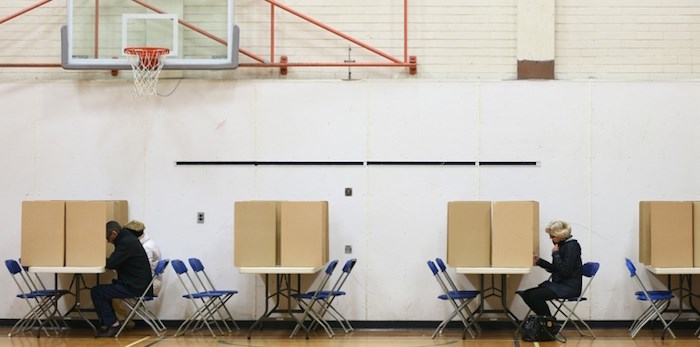Byelection campaigns can be extremely complex events.
Voter turnout tends to be lower than in a regular electoral contest, when all the seats in a particular legislative body are at stake. Potential voters are often disengaged and disenchanted, and the lack of deep media coverage leads to citizens not even knowing that they have a chance to exercise their franchise.
 With nearly 160 candidates to choose from, listed in random order, voters have their work cut out for them this election. Photo Dan Toulgoet
With nearly 160 candidates to choose from, listed in random order, voters have their work cut out for them this election. Photo Dan Toulgoet
In the case of the federal vote that will take place on February 25 in British Columbia’s Burnaby South constituency, the presence of the leader of the federal New Democratic Party (NDP) in the ballot has certainly added some interest. Jagmeet Singh seeks to be the first leader of the main three Canadian federal parties to represent a B.C. riding since Stockwell Day headed the Canadian Alliance.
The Burnaby South byelection was supposed to be an early test of strength for the NDP leader, as well as an indicator of whether the newly created People’s Party would eat into some traditional support for the federal Conservatives.
The race took a wild swing earlier this month, after a poorly worded statement from Liberal candidate Karen Wang was posted to social media platform WeChat and uncovered by the staff at Star Vancouver. In a span of 32 hours, Wang resigned, asked to be reinstated and flirted with a run as an independent. The Liberals have now named former provincial lawmaker Richard T. Lee as their standard bearer.
Wang’s demotion by the Liberal Party has precipitated a much-needed debate on the way political campaigns in Canada operate when it comes to courting so-called “multicultural” voters. Political consultants charge fortunes pretending to create a magic potion to engage with particular ethnic communities, and messages are crafted to make candidates appear more in touch with voters who immigrated to Canada. This can backfire quickly, as demonstrated in British Columbia by the 2013 “quick wins” scandal.
In elections of all types – municipal, provincial and federal – there is a tendency to make assumptions based on the demographic characteristics of a particular population. These assumptions are usually incorrect.
Just last year, we were treated to illusory media commentary that suggested that being married to a Filipino woman would propel a Â鶹´«Ă˝Ół»mayoral candidate to victory. The candidate finished in fifth place, as the supposed Filipino constituency that seemed discernible looking at census data never materialized.
In first-past-the-post elections, the futility of this misleading analysis becomes evident. There is more to a community than the origin of its residents. In Richmond, where 53 per cent of residents are of Chinese descent, three Chinese-Canadian candidates garnered 4,794 votes together. Incumbent Mayor Malcolm Brodie was re-elected with 30,452 votes.
The ability of an electoral contender to connect with voters of a particular ethnicity cannot measured by a last name, origin or ability to feature foreign languages in campaign paraphernalia.
A survey I conducted a few weeks before the 2015 federal election showed that voters in Metro Â鶹´«Ă˝Ół»of East Asian, South Asian and Southeast Asian descent placed “the candidate’s ethnicity” as the least important motivator for their vote. These “multicultural” voters were moved primarily by two issues: the candidate’s position on issues and the political party they represented.
Contrary to what data-less pundits believe, voters of a particular ethnicity do not cast their ballots as a block. In addition, the efforts of politicians to appear inclusive and mindful do not always move the needle. Last year, 69 per cent of British Columbians said that politicians who show up at ethnic festivals and celebrations are merely pandering for votes and are not truly interested in engaging with people from different backgrounds and cultures.
The proportion of voters who are not amused by public servants suddenly showing interest in ethnic celebrations included 76 per cent of residents of South Asian descent, 70 per cent of Europeans and 62 per cent of East Asians – something to ponder the next time politicians don traditional garb for Vaisakhi.
Regardless of the result in Burnaby South, a conversation about treating “multicultural” voters as a commodity has started. It will be interesting to see if political parties learn from Wang’s demise and work harder on policy development and meaningful community outreach, instead of trying to score points with their last names or birthplaces.
The political climate of the country has evolved to a point where candidates do not need to advertise themselves as “the only [insert ethnicity here] in the race.” Let’s hope that situations like the one that led the Liberals to replace their Burnaby South byelection candidate are the exception – and not the norm – in the next federal campaign.


.jpg;w=120;h=80;mode=crop)